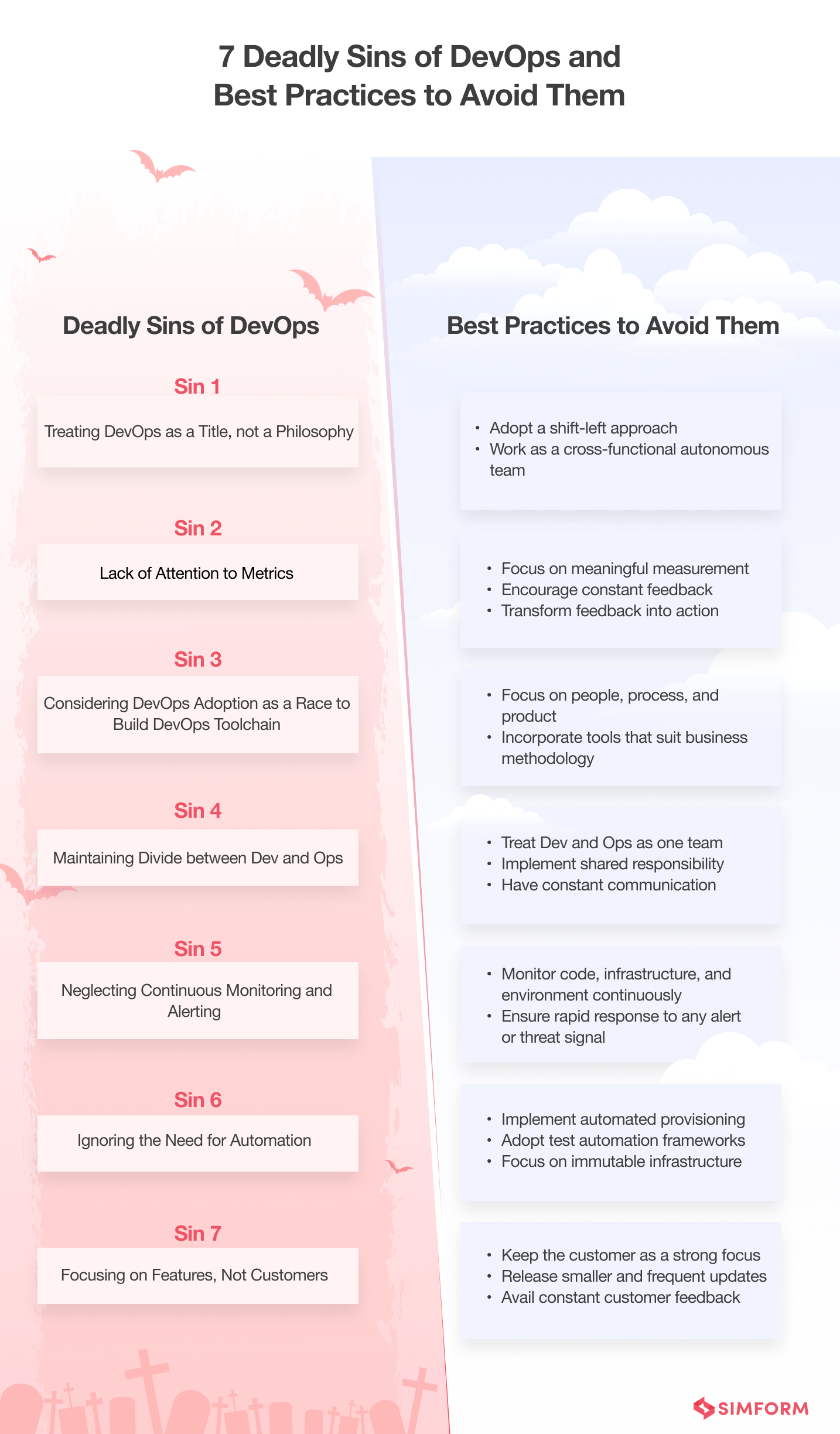Businesses need to adapt fast to the ever-changing market trends and the software industry is playing a pivotal role in that with digital transformation. From traditional development, we have moved to agile, lean development, and now DevOps. 86% enterprise-level firms, 71% mid-level organizations, and 35% small businesses have adopted DevOps. It suggests that DevOps will be an integral part of enterprises, with the DevOps market size expected to reach $10.31 billion by 2023.
Tech giants like Amazon, Netflix, Etsy, NASA, Walmart, Nordstrom, etc., have successfully adopted DevOps, and the prime reason behind that was a keen understanding of the principles of DevOps and best practices. So, if you’re considering embracing this cultural shift of people, processes, and products, you’re at the right place. This article will provide an insightful perspective on the principles and best practices by incorporating words of wisdom from industry experts who have “been there and done it before.”
8 key DevOps principles discussed by industry experts
1. Collaboration: Align people, processes, and tools to better serve customers
Collaboration is the heart and soul of DevOps principles.
Here’s what Jacob Lehrburm, SVP, Customer 360 Marketing at Salesforce, said about the importance of increased collaboration:
“Breaking down silos and bringing development and operations teams together, companies can align their people, processes and tools towards a unified focus on the customer.”
Development and operations are two significant teams working cohesively on a common goal. Therefore, constant collaboration and communication are paramount for implementing DevOps in your company.
Here’s Mark Levy, Sr. Director, Product Marketing, OpsMx sharing his thoughts on the same.
“The best way for Dev and Ops to collaborate is to first get alignment and ensure everyone is pushing in the same direction. If your Ops team is measured only by mitigating risk and your Dev teams are measured only by delivering change, we have a conflict. Moving fast and not breaking things is everyone’s responsibility.”
2. Automation: Self-regulating repetitive tasks to increase production output and lower operational costs
Automation is a DevOps principle that makes your business process more efficient by performing several pre-defined steps consistently.
Here’s George Miranda, Head of Ecosystem and Partnerships at HoneyComb.io, putting it attractively. He says,
“Automation is a key step toward [CI/CD] or the ability to rapidly release new software to your customers. This includes automation of infrastructure provisioning, the building of new systems, software deployment and a gauntlet of tests to verify everything from functionality to security compliance. By automating all of those steps, machines can be trained to deploy software faster, safer and more reliably than ever.”
Another DevOps expert David Farley, author of a bestselling book Continuous Delivery: Reliable Software Releases through Build, Test, and Deployment Automation, highlights the need for automation. He says,
“Asking experts to do boring and repetitive, and yet technically demanding tasks is the most certain way of ensuring human error that we can think of, short of sleep deprivation, or inebriation.”
Here is the DevOps automation checklist that will help you know where to start, what is the entire process, and what actions to take to achieve this goal successfully.
| Steps | Action |
| Code Automation | Automate code check and remove manual processes to have a single source of truth for whole teams. |
| Requirements Testing | Automate requirement testing for code check-in using a predefined set of rules to review source code for bugs or security issues. |
| Performance Automation | Automating tests verify an application’s performance by analyzing speed, scalability, and stability. |
| Auto-Deployment | Setting up auto-deployment and version control of application code to ensure continuous deployment and faster product delivery by eliminating testing or deployment cycle errors. |
| Environment Provisioning Automation | Automating entire development and deployment environments with continuous deployment tools. |
| Compliance Automation | It’s generally a part of environment provisioning automation where you automate the discovery and anonymization of personal information. |
3. Continuous improvement: Identifying opportunities to streamline workflow and reduce wastage of resources
People have questions about “how agile and DevOps work together?” Is the agile software development process related to DevOps? Or can you operate in DevOps without Agile? The principle of continuous improvement aims to answer these questions. Continuous improvement is a set of practices adopted from agile methodology only, so you can say they’re related.
Here’s Waleed Bekheet, Founder & CEO at Protagona, explaining how continuous improvement incorporates the nitty-gritty of agile to help implement other DevOps best practices. He says,
“Continuous improvement supports continuous integration and continuous delivery (CI/CD) DevOps pipelines through optimized processes and automation. A CI/CD pipeline approach enables efficiency in the building and deployment of applications, and automated application deployment allows for rapid release with minimal downtime.”
Another DevOps expert, Kevin Goldsmith, Chief Technology Officer (CTO) at Anaconda, highlights the importance of continuous learning and improvement in DevOps. He says,
“Continuous improvement is an ongoing effort to improve products, services, or processes. These efforts can seek “incremental” improvement over time or “breakthrough” improvement all at once.”
It also helps you bring more customer value as they will access new features continuously, enhancing their experience and enriching them.
4. Customer-centric action: Keeping customers as a central figure to drive growth and competitive advantage
Industry experts have defined DevOps principles and practices by keeping customer needs in mind.
Jeff Bezos, Executive Chairman of Amazon, has a take on building a customer-centric approach. He says,
“Customers are always beautifully, wonderfully dissatisfied, even when they report being happy and business is great. Even when they don’t yet know it, customers want something better, and your desire to delight customers will drive you to invent on their behalf.”
For having a customer-centric approach, the organization can follow some best practices:
- Continuous innovation with the trial and error method
- Adjusting and changing a strategy when it’s not working
- Constantly investing in features, services, or products that enhance customer experience
- Rapidly responding to changing or emerging customer trends
George Miranda, Head of Ecosystem and Partnerships at HoneyComb.io, has a piece of advice on delivering customer-centric action. He says,
“Just because you capture customer metrics, that doesn’t mean you should obsess on all of them. Start by focusing on the basics: time between initial software commit and having that change running in production, the error rate when deploying new software to production, or mean-time to recovery whenever service interruptions occur. But to find the signal in the noise, focus on the metrics that matter to your company and your users first.”
5. Creation with ‘end-in-mind’: Develop software with a clear vision
If you don’t know your destination, you will wander all over the place and waste your time, energy, and resources. The same applies to DevOps, where knowing the end goal is paramount. Once you’ve clarified that, you can ideate your ideal product, service offering, and everything related. However, for implementing these core principles of DevOps, having an engineering mindset and trust among development and operations team members is cardinal.
Hiren Dhaduk, VP of Technology at SIMFORM, advises all budding organizations who want to adopt DevOps. He says,
“With my experience of working and overseeing the implementation of DevOps for various organizations, I can tell you that having a vision of what you want to build is paramount. A communication gap between you and the client can put you in a catch-22 situation upon final release. Involving your client and making them an active part of your operations will seal the deal for you.”
6. End-to-end responsibility: Organizing teams vertically to attain higher productivity and quality
In a traditional production environment, development and operations teams work separately; they don’t communicate often, and each is accountable only for a particular phase of the development lifecycle. However, the DevOps environment encourages organizations to provide end-to-end responsibility to all DevOps teams for continuous development.
Dave Blakey, CEO at Snapt, shares an interesting perspective on why there’s a need for end-to-end responsibility. He says,
“One of the core principles of DevOps is the control and responsibility of services from concept to grave. Traditionally, developers write code and operations deploy that code, but that leads to all sorts of inefficiencies from differences in production to performance problems and unpredictable environments.”
7. Cross-functional autonomous team: Developing self-sufficient teams to deliver resilient IT services in timely manner
Autonomy is one of the key principles of DevOps, and cross-functional teams are one of the ways to achieve that. These teams need to be self-empowered and take on any hands-on challenge from creativity, design, build, test or deployment.
Patrick Debois, Independent DevOps and DevSecOps Advisor, Principal Engineer, Public Speaker, and father of DevOps, has an interesting take on this subject. He says,
“DevOps is a human problem. Doing DevOps requires an organizational culture that brings development and operations people together so that they can understand each other’s perspectives and concerns. The aim is to enable both the teams to build and deliver resilient IT services that are production-ready, in a timely manner.”
Look for people who fit into a T-shaped profile, which means having in-depth knowledge of primary skills and a basic understanding of other areas related to software development. For example, a person specializing in development should also have a basic knowledge of deployment and testing. In addition, they should be able to collaborate with other teams.
8. Incremental releases: Releasing software in smaller units to minimize risk and delivery cost
Continuity in everything you do is one of the foundational principles of DevOps culture, and incremental release is an aspect that supports that.
Jez Humble, SRE at Google Cloud and author of the award-winning book Continuous Delivery, puts his thoughts on how incremental release contributes to automation. He says,
“Businesses rely on getting valuable new software into the hands of users as fast as possible, while making sure that they keep their production environments stable. Incremental release is a revolutionary and scalable approach to software delivery that enables any team, including teams within enterprise IT organizations, to achieve rapid, reliable releases while reducing delivery cost and risk.”
These were the essential principles of the DevOps lifecycle that lay the foundation for organizational success regarding faster release and high-quality assurance. However, for successfully implementing these principles in your organization, it’s vital to understand best practices. So, let’s dive deep into each of them in our upcoming section.
Now you can make a successful DevOps strategy following this simple steps
7 deadly sins of DevOps and best practices to avoid them
Once you’ve known DevOps principles, you’re ready to implement them in your organization, and there are DevOps best practices that assist you in that regard However, the ride is not so smooth as DevOps is a massive ecosystem with various elements. You may make mistakes, which may hold you back from having the desired success with DevOps.
Below are the seven deadly sins of DevOps that can make your life hell. However, there is always a way out, and you can move from hell to heaven by following best practices.

Ensure faster releases by partnering with SIMFORM for DevOps
Launching multiple apps in a single week with manual procedures can be a huge obstacle to productivity. We at SIMFORM faced a similar scenario while working with Fitcom, a platform that helps people build custom healthcare solutions. That’s where our engineering team set up automated tests and deployment by building a Unix shell script that automatically generates the new build and versioning for iOS and Android. It helped Fitcom launch multiple applications successfully while also saving time and gaining a competitive advantage by faster time-to-market.
Adopting DevOps requires sound technical knowledge, some soft skills related to collaboration, and better communication to execute correctly. You also need to know various DevOps principles and best practices. With so much on your platter at one go, you need an industry expert with the knowledge and experience to deal with DevOps. This is where SIMFORM can be your ideal partner. We’re one of the top-rated DevOps consulting firms that helps you achieve faster development, fewer bugs, and frequent delivery. So, contact us for expert consultation and avail a reliable solution.

